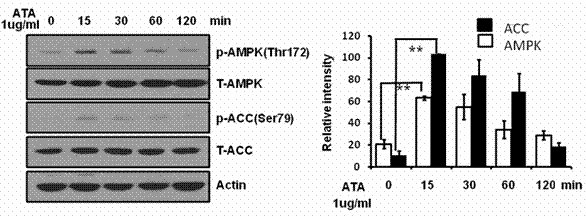Anti-insulin resistance adenosine monophosphate-activated protein kinase agonist
A technology of Aralis saponin and Aralia taibai, applied in the field of biomedicine, can solve problems such as difficulty, and achieve the effects of low price, strong AMPK agonistic activity, and few adverse reactions
- Summary
- Abstract
- Description
- Claims
- Application Information
AI Technical Summary
Problems solved by technology
Method used
Image
Examples
Embodiment 1
[0023] Example 1: Effect of araloside on C2C12 muscle cell AMPK and its target protein ACC
[0024] The differentiated C2C12 muscle cells were randomly divided into 5 groups: (1) control group (0min group), C2C12 muscle cells; (2) 15min group, C2C12 muscle cells were collected with 1 μg / ml araloside for 15 minutes; (3 ) 30min group, C2C12 muscle cells were given 1μg / ml araloside for 30min to collect; (4) 60min group, C2C12 muscle cells were given 1μg / ml aralin for 60min to collect; (5) 120min group, C2C12 muscle cells were given 1μg / ml ml of araloside was collected in 120min.
[0025] Cells were washed with PBS (pH 7.4) pre-cooled to 0°C and transferred to pre-cooled lysate [Tris HCl 20, NaCl 50, NaF 50, NaF 4 P 2 o 7 50, Sucrose 250, Na 3 VO 42, DTT 1 (mmol / l) and 1% compound protease inhibitor]. BSA protein quantification kit for protein quantification. The samples were subjected to SDS-PGEA electrophoresis, and the proteins were transferred to polyvinylidene fluorid...
Embodiment 2
[0026] Example 2: Effects of Araloside on Glucose Uptake and Fatty Acid Oxidation in C2C12 Muscle Cells
[0027] Treat C2C12 muscle cells with 1ug / ml araloside for 15min, and use radioactive isotope-labeled glucose 2-deoxy-[1- 3 H]-glucose was used to detect the uptake of glucose by cells, and the release rate of CoA-SH was used to evaluate the activity of CPT-1. The results showed that araloside significantly increased the uptake of glucose by C2C12 myoblasts (see figure 2 left) and CPT-1 activity (see figure 2 right).
Embodiment 3
[0028] Example 3: Effect of araloside on insulin-resistant C2C12 muscle cells AMPK and its target protein ACC
[0029] The insulin-resistant C2C12 muscle cells were randomly divided into 5 groups: (1) control group (0min group), insulin-resistant C2C12 muscle cells; (2) 15min group, insulin-resistant C2C12 muscle cells were given 1 μg / ml The wood saponins were collected for 15 minutes; (3) 30 minutes group, insulin-resistant C2C12 muscle cells were given 1 μg / ml araloside for 30 minutes to collect; (4) 60 minutes group, insulin-resistant C2C12 muscle cells were given 1 μg / ml araloside for 60 minutes to collect (5) In the 120min group, insulin-resistant C2C12 muscle cells were collected with 1 μg / ml araloside for 120 minutes.
[0030] The detection method of AMPK and ACC is the same as in Example 1, and the experimental results show that araloside significantly increases the expression of phosphorylated AMPK and ACC in insulin-resistant C2C12 muscle cells (see image 3 ), sugg...
PUM
 Login to View More
Login to View More Abstract
Description
Claims
Application Information
 Login to View More
Login to View More - R&D
- Intellectual Property
- Life Sciences
- Materials
- Tech Scout
- Unparalleled Data Quality
- Higher Quality Content
- 60% Fewer Hallucinations
Browse by: Latest US Patents, China's latest patents, Technical Efficacy Thesaurus, Application Domain, Technology Topic, Popular Technical Reports.
© 2025 PatSnap. All rights reserved.Legal|Privacy policy|Modern Slavery Act Transparency Statement|Sitemap|About US| Contact US: help@patsnap.com



